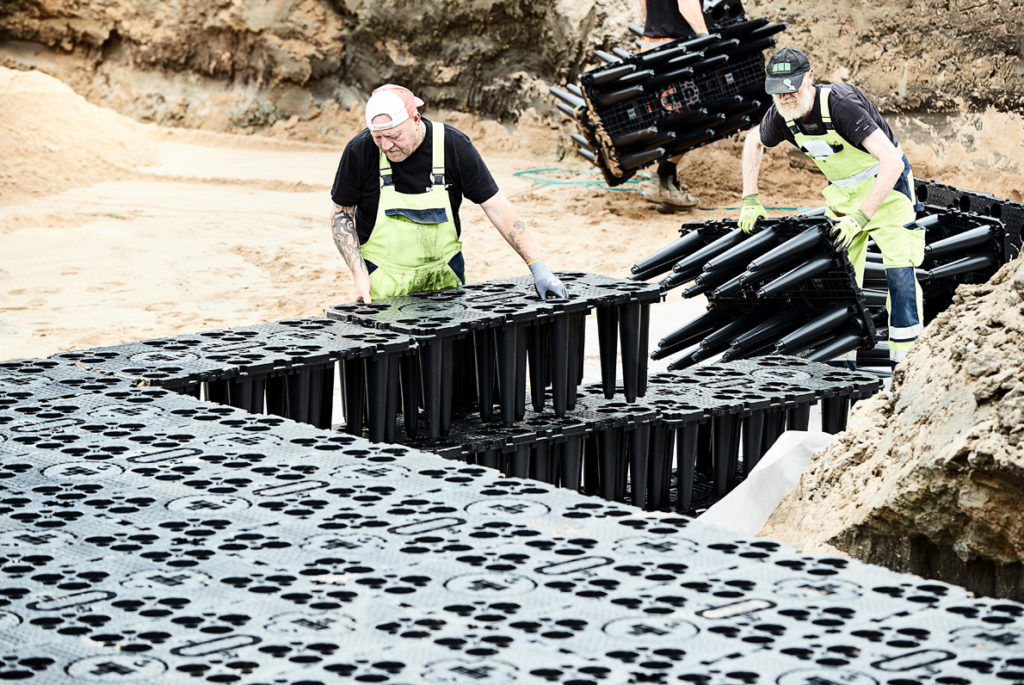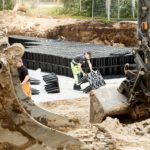As the Great British summer picks up again, so too do the cycles of dry heat and stormy downpours that put pressure on our out-dated water infrastructure. Sustainable drainage systems (SuDS) are the solution that industry figures and legislators are turning to, but their implementation is easier said than done in urban locations where space is often at a premium. Here, Martin Lambley, Product Manager for Urban Climate Resilience at Wavin explores how the latest systems are designed to work in a tight spot.
The fluctuation between long dry spells and heavy thunderstorms can stretch water infrastructure to breaking point, with out-dated drainage that solely moves water out of town as quickly as possible often unable to cope with intense rainfall events. By contrast, sustainable drainage systems (SuDS) mirror the natural water cycle, and the latest solutions are designed to be implemented quickly and safely in the impermeable urban environments where they’re needed most.
Stackable safety
SuDS come in all shapes and sizes, often combining natural and human-made components. Attenuation tanks are one type of SuDS that play a key role in mitigating the impact of heavy rainfall. However, these can be large and bulky, which poses a unique challenge in urban locations where space is more restricted. Projects are under pressure to avoid delays, which is why it is important to opt for rainwater solutions that are straightforward to install while still offering the necessary performance to perform long into the future.
The latest generation of attenuation tanks are designed to fit smoothly into the construction process, even in tight urban spaces. The AquaCell NG attenuation tank from Wavin is a great example of this kind of technology, featuring an innovative stackable design that means it can be stored in a quarter of the space of previous generations. This helps to improve site safety by decluttering the work area.
Site access is also no trivial matter in urban developments, where higher population density means projects are likely to have a greater impact on the community.
Frequent deliveries can complicate the relationship between the project and the surrounding area, as well as incurring the cost of closing roads if necessary. The stackable design of AquaCell NG means four times more product can be delivered each time, vastly reducing the disruption and making for a faster process overall.

More in, less stall
Manufacturers have learned to walk in the shoes of those implementing their solutions on site, which has led to many embracing push-fit connectivity, which makes for a more straightforward build as well as a much faster job — reducing the number of people needed in the trench.
Flexibility is another attribute that’s worth its weight in gold in urban environments — there’s no one-size-fits-all worksite, and the need for adaptability is spurring a rise in popularity of modular design. It gives architects and designers the freedom to fit attenuation tanks into whatever shape works for them, and with manufacturers such as Wavin having technical design specialists on-hand to advise, these powerful SuDS are now a more effective option on more projects.
Designed for the future
Local authorities have an obligation to ensure housing stock is built to last. Clearly, guarding against flood damage is a key part of this, with housing associations potentially liable for any repairs to fixtures and fittings that may be required. From a financial perspective, opting for fit and forget technology that provides long-term defence against heavy rainfall can therefore provide peace of mind for local authorities.
New legislation is also on the horizon that will mandate further inclusion of sustainable drainage in plans for new developments. Schedule 3 of the Water and Environment Act is set to come into force in 2024 and will require developers to submit plans for sustainable drainage for approval before work can begin (1).
The new regulations point to a consensus among industry leaders and legislators that we can’t afford not to embrace SuDS on a large scale. However, successful implementation of Schedule 3 will require collaboration to ensure that the new rules take off rather than put pressure on developers. It means helping everyone get up to speed with the legislation and the solutions available.
The impact of climate change on our weather patterns will only increase in the coming years — 2023 is shaping up as the hottest year on record — which is bad news for an urban water cycle and will only cause further problems if we don’t intervene. SuDS are a game-changer, but they need to work on tricky urban worksites too. With Schedule 3 on the horizon, next-generation attenuation tanks need to be city-smart and quick to install to meet the urban water management challenge.










